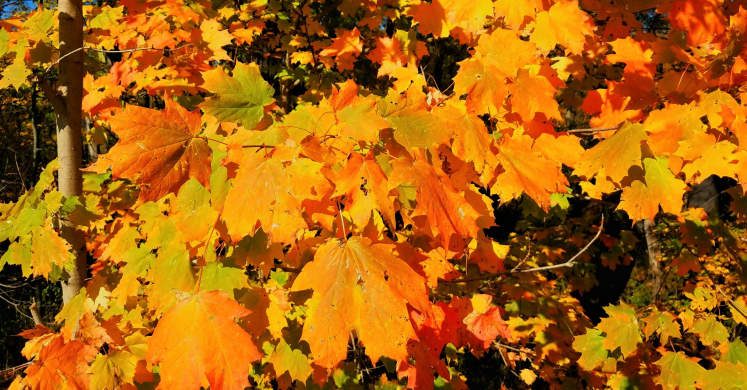Blog

#bioPGH Blog: Wandering Through the Leaves
 A resource of Biophilia: Pittsburgh, #bioPGH is a weekly blog and social media series that aims to encourage both children and adults to reconnect with nature and enjoy what each of our distinctive seasons has to offer.
A resource of Biophilia: Pittsburgh, #bioPGH is a weekly blog and social media series that aims to encourage both children and adults to reconnect with nature and enjoy what each of our distinctive seasons has to offer.
In a year that has brought quite a bit more than we bargained for, the vivid reds, oranges and yellows of autumn leaves have been a welcome sight. This weekend, I grabbed a thermos of pumpkin spice and hit some trails with friends, blissfully soaking in the nature and the sheer nostalgia of a crisp, fall day — I was not disappointed. Color was everywhere, and a few different moments even brought yellow leaves swirling down from the trees to us on the ground below. Of course, an autumn day in the woods brings the biology questions to mind: why and how do leaves change color? The brilliant display must be costly to the trees, and they wouldn’t go through all of that work nothing — let’s explore!
Why do trees drop their leaves in the first place? Essentially, because leaves have no purpose in the winter. Normally, the main job of a leaf is to produce food for the plant via photosynthesis, but when the weather is too cold, enzymes (molecular “machines”) in leaves can’t properly function, and thus can’t photosynthesize. On top of that, ice formation can destroy leaf tissue, which is energetically expensive for a tree to repair. Overall, that means during the winter, leaves would simply be a costly but non-functional feature — so it’s much easier to just let them go every fall and regrow in the spring!
Now, how do leaves actually go about this process? Trees receive the cue to start dropping their leaves based on a combination of temperature and the change in photoperiod (day length). Once these signal fall weather, leaves start withdrawing any available resources and nutrients from leaves back to the tree. In the process, the leaves break down non-essential compounds, like the green chlorophyll that normally is responsible for photosynthesis. As the chlorophyll breaks down, the colors that emerge are generally reds, oranges, yellows and purples. These are all from other pigments that are present in leaves all throughout the summer, but since they are generally in lower quantities than chlorophyll, the green masks their presence. As the chlorophyll breaks down, we start to see pigments like anthocyanins, which make the red and purple, and carotenoids, which produce yellows, reds and oranges.
Before the leaves have all fallen, try to get outside and explore a little! And if you haven’t been to a state or county park in quite a while (or if you go often and need a few new ideas), below are a few things to try to spice up your time wandering through the leaves. Enjoy!
Look for the Hidden Gems
Pause now and then to investigate the leaf litter on the ground. What is in the leaves? Do you notice any invertebrates? Maybe the shiny, iridescent sheen of microbes breaking down wet leaves? Do you spy any movement in the leaves in the distance? Perhaps from a small mammal or bird hopping about? Walk slowly and look for little hidden moments like these — the wonder never gets old!
Bring a Notebook and Jot Down Whatever Comes to Mind
Capture your observations and experiences. Maybe you’re stunned by the beauty of the leaves. Maybe you smell something rather potent and musky gross, and you’re not sure if it’s a skunk, a fox or animal scat. Or maybe a poem or story idea comes to mind … or has been in your mind a long time and it’s just so hard to make that first stroke of the pen. Let the whimsy and comfort of falling leaves be your muse!
Bring the Little Ones and Make the Hike a Scavenger Hunt
As you walk, make a point to look for items and creatures that are different colors, listen for different sounds, walk like the different animals you might see. And don’t forget to get good and muddy!
Allow Your Mind to Be Empty
Maybe you don’t do or look for anything! Give yourself permission to forget the rest of the world for even just an hour. Turn off your electronics, if you can. Don’t walk for speed or calories burned — just meander. Don’t make yourself feel anything or be anything. This one is actually quite difficult for me; I have to be intentional. But my goodness do we all need some time for refreshment.
Have fun as you explore, and if you find something exciting or would just like to share some thoughts, drop them in the comments below or email me at mwheeler-dubas@phipps.conservatory.org. See you next week!
Resources
MIT News—The Mathematics of Leaf Decay
SUNY ESF—Why Leaves Change Color
#bioPGH Blog: The Story of a Leaf

